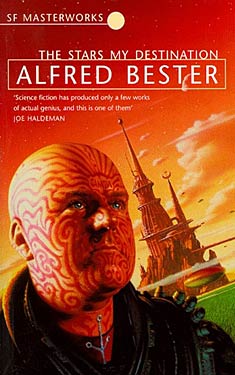Alfred Bester
Completed 3/10/2018, reviewed 3/10/2018
4 stars
The only previous Bester I had read was The Demolished Man,
his Hugo winning novel. I liked it but
wasn’t thrilled. I much more enjoyed The
Stars My Destination. I felt the prose
was much better and the story overall was much more interesting. It’s strange because this book has been
called a proto-cyberpunk version of The Count of Monte Cristo, and I usually
don’t care for cyberpunk. Somehow, this
book grabbed me in the prologue and kept me glued to it to the end.
The plot is pretty complex.
The time is the future, where teleportation, or jaunting, is the main
means of travel. People can jaunte up to
1000 miles at a time. Space and time
jaunting has not yet been discovered. This
has disrupted the economy so badly that war has erupted between the Inner
Planets and the Outer Satellites. It’s
in this time of the turbulence that Gulliver Foyle, low ranking gutter trash on
the spaceship Nomad, is marooned in space after what was probably an attack by
the Outer Satellites. An Inner Planets
ship, the Vorga, comes close enough to rescue him, but doesn’t. From then on, Gully Foyle develops a mad
obsession to destroy the Vorga.
In addition to this story line, it turns out that the Nomad
was carrying a secret cargo that has the potential for ending the war. There is also some secret about the Vorga
that people are dying over. Lastly,
Gully himself may have a secret that could be even more important than ending
the war.
Gully is an anti-hero, a protagonist that will rape,
torture, and murder to see his plan of vengeance succeed. He has such a one-track mind, that he cannot
be tortured into revealing what happened to the Nomad. Despite being so morally depraved, I really
liked Gully. I especially liked him when
he was speaking in gutter slang. I didn’t
like what he did, but his character develops as the plot moves along, and he
does get a sort-of redemption in the end.
While this book doesn’t pass the Bechdel test (I’m pretty
sure none of the female characters ever speak to each other), the female
characters are rather strong for a novel from the ‘50s. They all have or had some type of career, for
good or for bad, and all play a part in Gully’s redemption.
I find it interesting that Bester again plays with form like
he did in The Demolished Man. He uses
different patterns of text and strings of characters to get across a situation
where Gully’s senses become crossed. It’s
difficult to describe here. It has to be
read.
The prose is tremendous.
As I mentioned earlier, it really shines in the beginning until the plot
grips you and keeps you going to the end.
Different layers of the plot keep the story from devolving into a simple
adventure story, and the climax is very satisfying. I give this book four stars out of five.

No comments:
Post a Comment